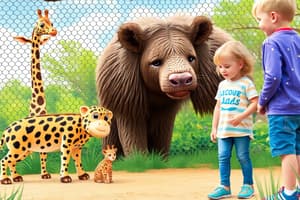Podcast
Questions and Answers
¿Cuál es el propósito educativo de las historias infantiles que presentan animales?
¿Cuál es el propósito educativo de las historias infantiles que presentan animales?
- Enseñar a los niños sobre diferentes especies animales y sus hábitats. (correct)
- Mostrar aventuras sin ninguna relación con la naturaleza.
- Entretener a los niños sin ningún objetivo educativo.
- Presentar a los animales como personajes secundarios sin importancia.
¿Qué lección específica sobre la vida de una mariposa enseña el personaje de la oruga en 'La Oruga Muy Hambrienta'?
¿Qué lección específica sobre la vida de una mariposa enseña el personaje de la oruga en 'La Oruga Muy Hambrienta'?
- La habilidad de volar de una mariposa.
- La alimentación de una mariposa adulta.
- El ciclo de vida de una mariposa. (correct)
- Los colores brillantes de las alas de una mariposa.
¿Qué función pueden cumplir los animales en las historias infantiles según el texto?
¿Qué función pueden cumplir los animales en las historias infantiles según el texto?
- Elementos decorativos sin relevancia para la trama.
- Villanos exclusivamente.
- Acompañantes mudos sin importancia.
- Protagonistas, personajes secundarios o guías de moral. (correct)
¿Qué elemento principal destaca en la serie 'Oso en la Silla' de Ross Collins?
¿Qué elemento principal destaca en la serie 'Oso en la Silla' de Ross Collins?
¿Cuál es uno de los propósitos principales que cumplen los animales en las historias infantiles según el texto?
¿Cuál es uno de los propósitos principales que cumplen los animales en las historias infantiles según el texto?
¿Qué propósito suelen cumplir los animales en las historias infantiles?
¿Qué propósito suelen cumplir los animales en las historias infantiles?
¿Qué característica suelen tener algunos animales fantásticos en las historias infantiles?
¿Qué característica suelen tener algunos animales fantásticos en las historias infantiles?
¿En qué historia infantil el personaje principal aprende una valiosa lección sobre obediencia?
¿En qué historia infantil el personaje principal aprende una valiosa lección sobre obediencia?
¿Qué enseñanza suelen transmitir los animales que son protagonistas en las historias infantiles?
¿Qué enseñanza suelen transmitir los animales que son protagonistas en las historias infantiles?
¿Qué característica distingue a los animales realistas en las historias infantiles?
¿Qué característica distingue a los animales realistas en las historias infantiles?
¿Qué característica suelen tener los animales antropomorfizados en las historias infantiles?
¿Qué característica suelen tener los animales antropomorfizados en las historias infantiles?
Flashcards are hidden until you start studying
Study Notes
Animals in Children's Stories
Children's stories often feature animals as characters, providing young readers with a way to relate to and learn from these creatures. Animals in these narratives can be realistic or fantastical, and their presence can serve various purposes.
Realistic Animals
Realistic animals in children's stories can range from pets to wild animals. These animals often serve as supporting characters or help to illustrate a moral or lesson. For instance, in "The Tale of Peter Rabbit" by Beatrix Potter, the titular character is a rabbit who learns a valuable lesson about obedience when he disobeys his mother's instructions and gets into trouble.
Fantastical Animals
Fantastical animals in children's stories are often used to create unique and imaginative worlds for readers. These creatures can be anthropomorphized, meaning they have human-like characteristics or behaviors, or they can have abilities that are not found in real animals. An example of this is found in A.A. Milne's "Winnie the Pooh," where the bear character has an insatiable love for honey and a knack for getting into sticky situations.
Animals as Protagonists
In some children's stories, animals are the main characters. These stories often focus on the adventures of the animal(s) and can teach readers about friendship, problem-solving, and bravery. An example of this is the "Bear on the Chair" series by Ross Collins, where a bear who loves to sit on chairs goes on a series of adventures and learns to adapt to different environments.
Educational Value
Children's stories featuring animals can also serve an educational purpose. These narratives can introduce young readers to different animal species, their habitats, and their behaviors. For example, in "The Very Hungry Caterpillar" by Eric Carle, the caterpillar character undergoes a metamorphosis, teaching readers about the life cycle of a butterfly.
Conclusion
Animals play a significant role in children's stories, providing a way for young readers to connect with the narrative and learn valuable lessons. Whether they are realistic or fantastical, animals can serve as protagonists, supporting characters, or morality guides in these engaging and educational narratives.
Studying That Suits You
Use AI to generate personalized quizzes and flashcards to suit your learning preferences.




